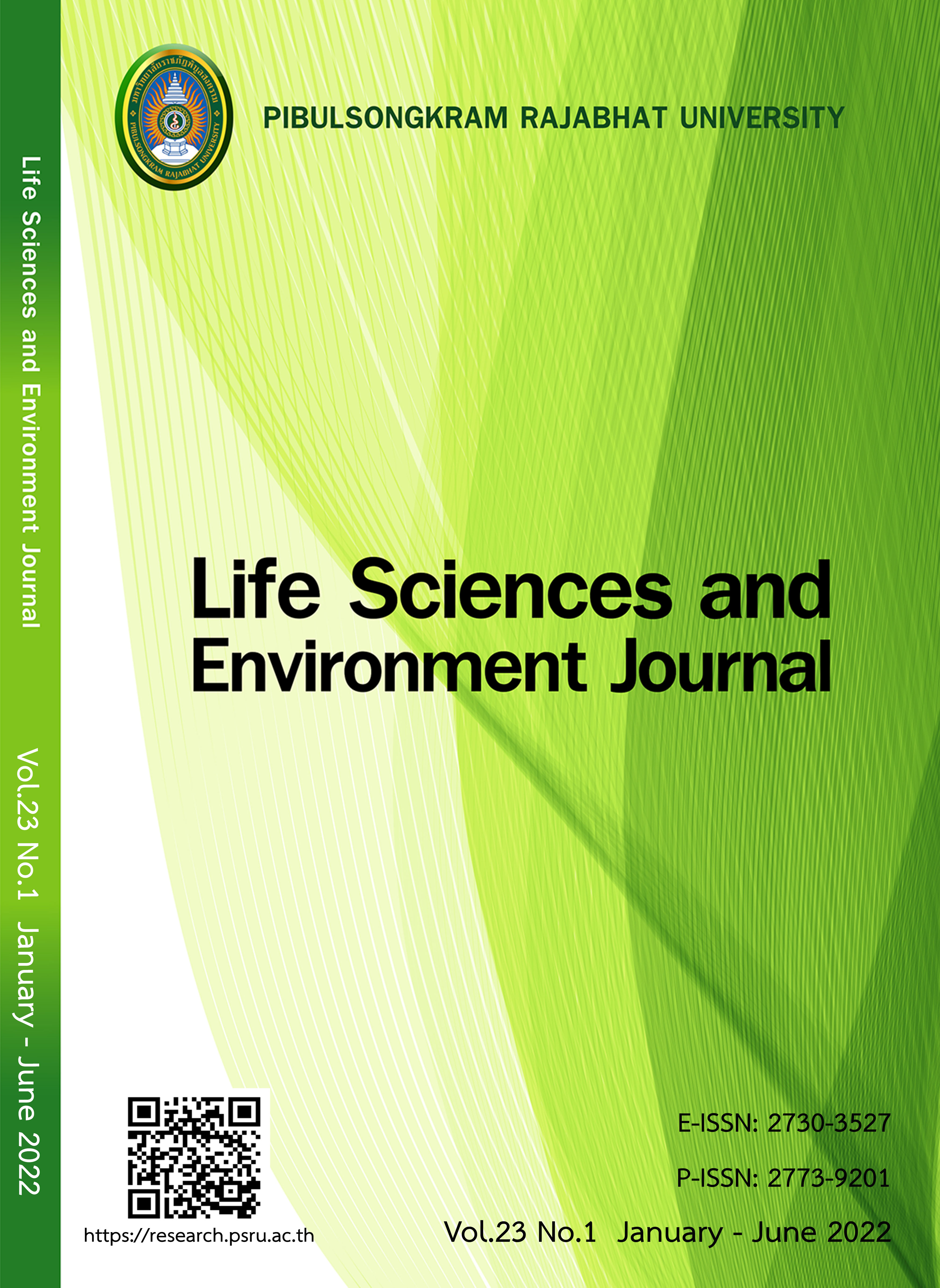THE CHEMICAL COMPONENT OF COSCINIUM FENESTUM (HAMM) STEM EXTRACTION AND THE REDUCTION EFFICACY OF PESTICIDE CHLORPYRIFOS RESIDUE IN YARD LONG BEAN (VIGNA UNGUICULATA).
DOI:
https://doi.org/10.14456/lsej.2022.10Keywords:
Coscinium fenestum (Hamm), Pesticide residue washing, Chlorpyrifos, Berberine, Yard long beanAbstract
Reduction of pesticide from vegetables using natural plant extract is the alternative way as environment friendly. This research aimed to study the efficacy of Coscinium fenestum (Hamm) stem extraction on reducing chlorpyrifos residue in yard long bean and its chemical components. The Hamm stems were chopped and extracted by maceration method. The supernatant was concentrated using a rotary evaporator and freeze dry. The crude extract was extended to various concentrations by water and used for washing the chlorpyrifos residue in yard long beans. The toxicant residue was detected by the GT-Test kit for organophosphate-carbamate pesticide group. The quantity of chlorpyrifos residue in yard long bean was confirmed by gas chromatography-mass spectrophotometer (GC-MS). The results showed that ethanoic extraction gave the highest ability to reduce the toxicant residue. In contrast, extraction with water is a convenient and environment friendly method. Moreover, Hamm extraction with water yielded a higher product than ethanoic extraction at 1.80 and 9.72 %w/w, respectively. The results found that ethanoic extraction 45% w/v at 48 hours of maceration with 10 minutes of washing had the highest efficacy to reduce chlorpyrifos residue. The GT-test kit cannot detect the toxicant residue and the chlorpyrifos residue detected by GC-MS revealed the reduction quantity of chlorpyrifos with efficacy at 99.02%. The most chemical components in Hamm extraction were Oleyl Alcohol from ethanoic extraction and 2,3-Butylene glycol in water extraction. Berberine detection was found in Hamm ethanoic extraction higher than that of water extraction at the same concentration.
References
Adachi A, Okano T. Pesticide residue reduction in selected vegetables using rice-bran. Journal of Health Science 2006;52(3):320-323.
Gouri S, Yogesh K, Tyagi R, Kumar G. Removal of Organophosphorus (OP) pesticide residues from vegetables using washing solutions and boiling. Journal of Agricultural Science 2012;4(2):69-78.
HafizUbaid UR, Waqas A, Wahab N, Mansur AS, Anwaar AN. A comprehensive review on chlorpyrifos toxicity with special reference to endocrine disruption: Evidence of mechanisms, exposures and mitigation strategies. Science of The Total Environment 2021;755(2):142-149.
Hattori M, Nakabayashi T, Lim Y. Inhibitory effect of various ayuravedic and panamanian medicinal plants on the infection of herpes simplex virus-I in vitro and in vivo. Phytotherapy Research 1995;9(4):270-276.
Singh GB, Singh S, Malhotra S. Hypotensive action of Coscinium fenestratum stem extract. Journal of Ethnopharmacology 1990;30(2):151-155.
Jiguo W, Tiangang L, Chongyu L, Thomas WL, Gilbert YS. Removal of residual pesticides on vegetable using ozonated water. Food Control 2007;18(5):466-472.
Jinwang L, Guofang P, Fazheng R, Bing F. Chlorpyrifos-induced reproductive toxicity in rats could be partly relieved under high-fat diet. Chemosphere 2019;229(1):94-102.
Keawpradub S. The alkaloids from the stems of Cosciniun fenestratum (Gaertn.) Colebr. Master degree thesis. Chulalongkorn University, Thailand; 1992.
Klaus EA, Sigurd BO. Allergic contact dermatitis from oleyl alcohol in Elidel® cream. Contact Dermatitis 2006;55(6):354-356.
Masruri S, Warsito M, Adi P. Renewable oil extracted from Indonesian Srikaya’s (Annona squamosal sp.) seed: another potent source for biodiesel. The Journal of Pure and Applied Chemistry Research 2012:1(1);51-57.
Palasuntheram C, Lyer KS, De Silva LB, De SilvaT. Antimicrobial activity of Coscinium fenestratum Colebr. against Clostridium tetani, Indian Journal of Medical Research 1982;76(1):71-76.
Pinho PMM, Pinto MMM, Kijjoa A, Pharadai K, Diaz JG, Herz W. Protoberberine alkaloids from Cosciniun fenestratum, Phytochemistry 1992;31(4):1403-1407.
Rojsanga P, Gritsanapan W, Suntornsuk L. Determination of berberine content in the stem extracts of Coscinium fenestratum by TLC Densitometry. Medical Principles and Practice 2006;15(5):373-378.
Tawee R. Detoxification of organophosphate and carbamate by Thai herbal plants. Bachelor degree thesis. Boromarajonani College of Nursing Chiang Mai, Thailand; 2010.
Tha-in S, Dau HA, Dumri K. The enhanced carbamate adsorption of modified bentonite with Coscinium fenestratum. International Journal of Environmental Science and Development 2013;4(4):415-418.
Tushar KV. Coscinium fenestratum (Gaertn.) Colebr. A review on this rare, critically endangered and highly-traded medicinal species. Journal of Plant Sciences 2008;3(2):133-145.
Downloads
Published
How to Cite
Issue
Section
License
Copyright (c) 2022 Life Sciences and Environment Journal

This work is licensed under a Creative Commons Attribution-NonCommercial-NoDerivatives 4.0 International License.
Each article is copyrighted © by its author(s) and is published under license from the author(s).










